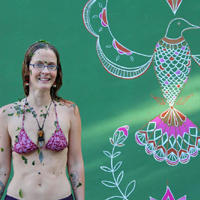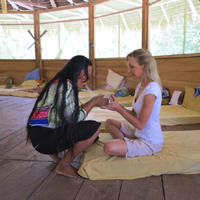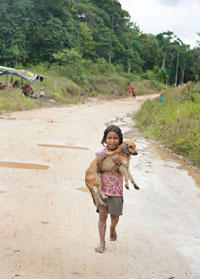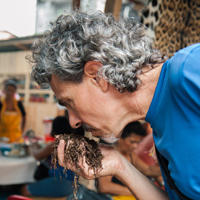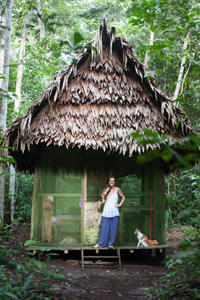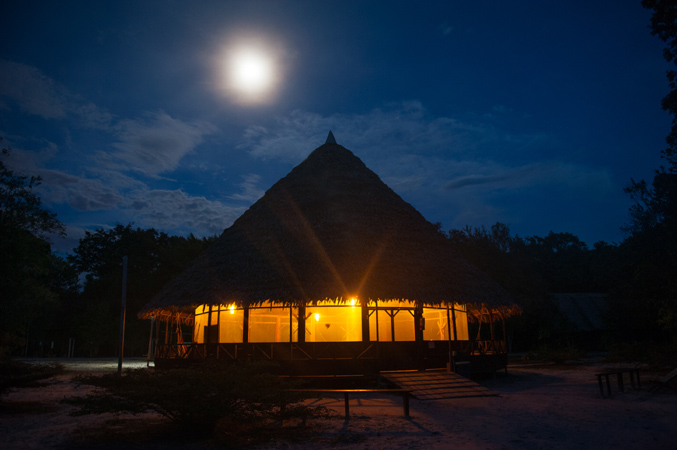
The Nihue Rao ceremonial maloka in the moonlight. Photo by Tracey Eller
Journeying into the cosmic sisterhood of the sacred vine
I sit cross-legged in front of a shaman, a juice glass full of viscous, ruddy liquid warming in my hand. It’s my second night of ceremony. It took two pours of ayahuasca to get me going last night, so this time he has poured me a lot.
I silently incant over the glass: Dear Mama Ayahuasca, I would like to look at the circumstances around my divorce tonight, what I still need to understand. And please show me anything else you want to show me.
In a spirit of abandon, I throw back my head and shoot the aya’ straight down my throat in one gulp. The crickets and frogs raise their volume in the night outside.
It’s on.
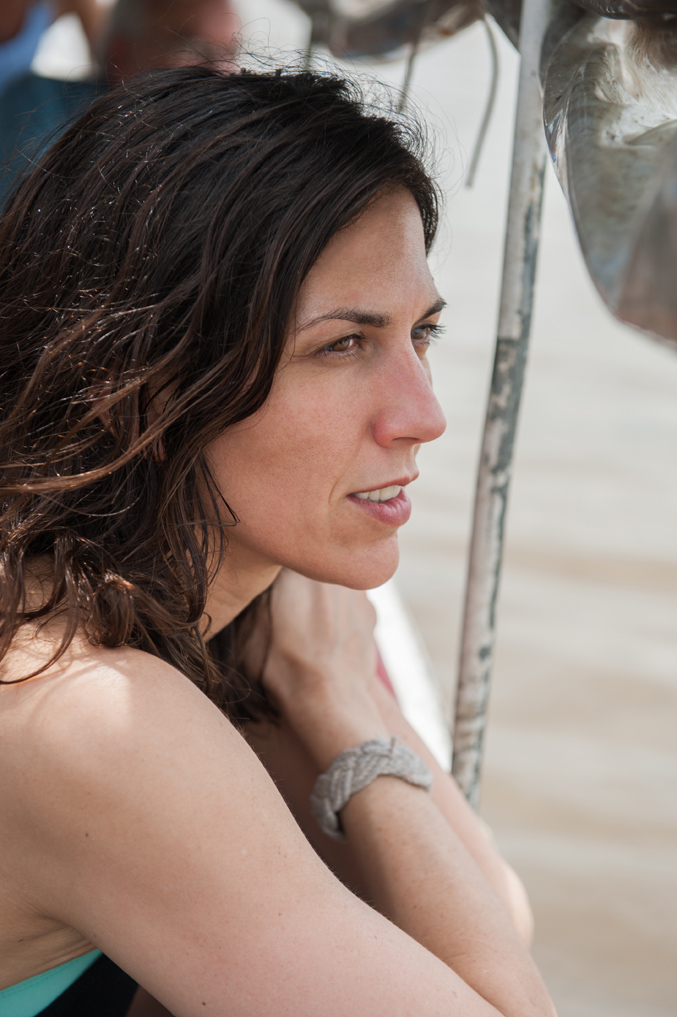 Laura Miller communes with wild river dolphin spirits, where the Amazon and Ataya rivers meet.
Laura Miller communes with wild river dolphin spirits, where the Amazon and Ataya rivers meet.
The Anteroom
I am in Perú as the recipient of a Plant Spirit Grant, funded by Zoe Helene’s company Cosmic Sister, which sponsors women to travel to the Peruvian Amazon rainforest for ayahuasca retreats. We are spending the week at Nihue Rao Centro Espiritual, a retreat center just outside Iquitos founded by shaman Ricardo Amaringo, Colombian-American physician Joe Tafur, M.D., and Canadian artist Cvita Mamic. The area around Iquitos is thick with such centers, and it is easy to spot ayahuasca tourists from all over the world—dreadlocked, tattooed, with a fey look in their eyes—in the cafés of the town.
Helene based the Cosmic Sister Plant Spirit Grant on the premise that although ayahuasca can be a means of healing and empowerment for women, so far, women still experience ayahuasca within the male-dominated cultures from which the practice derives. She wants to give voice to the women who drink ayahuasca, who in turn, in their own way, are giving voice to the vine.
I read The Ayahuasca Test Pilots Handbook (North Atlantic Books, 2014), written by Helene’s husband, ethnobotanist Chris Kilham, in preparation, and I had the good fortune to interview the women who had received the Cosmic Sister grant before me. I could be in dialogue with them, pursuant and interactive in a way you can’t be with a book.
The women in this cosmic sisterhood I was joining ranged in age from 24 to 63 (I am 42). They came to Perú for deeply personal reasons. Landscape architect Susan Sheldon, after losing both her mother and only sibling in a year, came to rediscover her own identity. “I was no longer my mother’s daughter, my brother’s sister,” she said. “A lot of our behaviors in life are predicated by the roles we play in relation to others. So who was I?” Amy Love, a mother who owns an eco-friendly housecleaning business, had been victimized and sexually assaulted by a man during the year she was separated from her partner. She sought to resolve that darkness.
Robyn Lawrence, an author and editor, had just left a magazine she’d run for eleven years and a longtime boyfriend. “I was living on my retirement. I was down to 93 pounds. I was struggling, really in a bad place, thinking ‘This was never supposed to happen to me.’ I was depressed, and I couldn’t figure out how to fix it.” And Rachel Carlevale, the youngest recipient, a sex educator at Planned Parenthood and a yoga teacher, sought to address the painful tumor in her uterus that was interfering with her ability to absorb nutrients. “Many people are down there seeking physical healing as a last resort,” Carlevale emphasized.
Psychologically and physically, ayahuasca is a kind of vegetable Lourdes—yet a daunting, formidable one. The women had to face down apprehensions based on what they had heard and read about it. “I knew I was going to do it, but I had read the National Geographic Adventure article so I was still apprehensive about it,” Love said, referring to a 2006 piece that makes experiencing ayahuasca sound like being dangled over an existential abyss.
It’s not for the faint of heart. An ayahuasca traveler has her share of ego-dismantling elements to face, even before the vine takes hold. She will be out of her element in a non-English-speaking country. She begins her journey with a vomitive that, Carlevale warned, produces “the most barf you’ve ever barfed.” And then there’s the purging and evacuation that can accompany the ceremony itself. It’s no wonder that, as she wrote down her intentions before each ceremony, Love asked the aya’ to be gentle.
I’ve come to Peru to seek out the originary strand of a complex web of events. I survived a psychologically abusive relationship after a catastrophic divorce that was my fault. I know that one is self-punishment for the other, but I don’t know where the strand begins. I want to understand them, and live a wiser life, by understanding of myself.
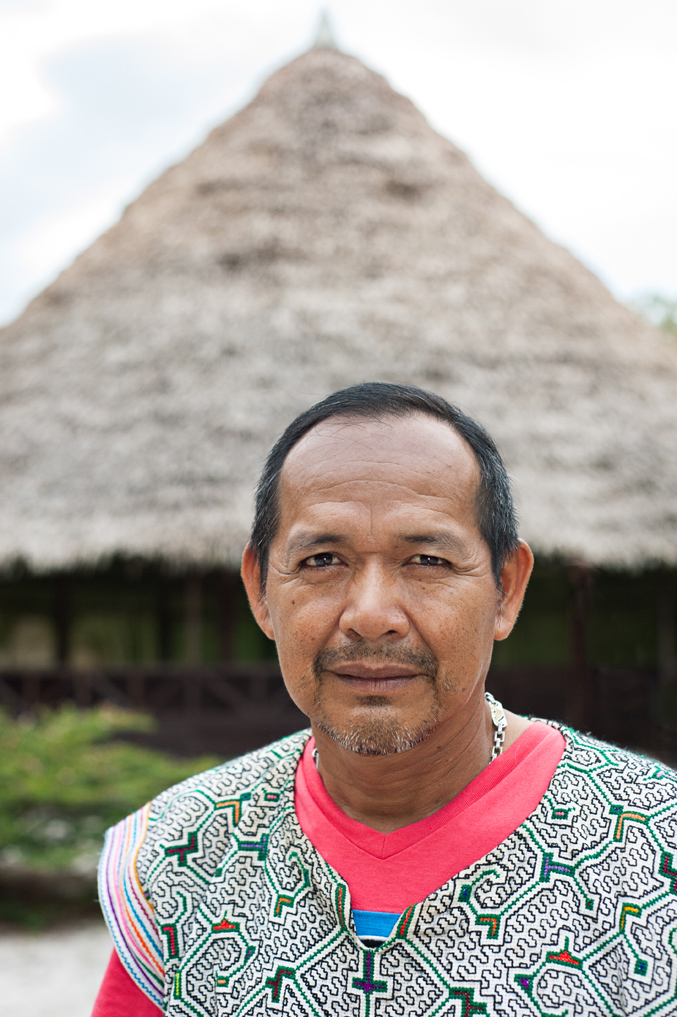 Shipibo maestro Shaman Ricardo Amaringo in front of the Nihue Rao ceremonial moloka.
Shipibo maestro Shaman Ricardo Amaringo in front of the Nihue Rao ceremonial moloka.
The Mareacion
Nihue Rao is much like an ayahuasca summer camp, complete with cabins, mosquito netting, a dining hall, an infirmary, and an arts-and-crafts building. The maloka, the ceremonial building in which the ceremonies take place, is the chapel—yet in this case, the sacred space is the central point of everything.
In my party are Zoe of Cosmic Sister and her husband, Chris, both seasoned ayahuasca journeyers, and also Tracey Eller, the sixth recipient of the Cosmic Sister grant who photographed this piece.
Each morning after ceremony, we and the other passajeros reconvene in the maloka for the shamans’ meeting. There, everyone can relate some of what happened in the previous night’s visions. The stories are especially informative for the shamans, who are always learning and applying new wisdom about how ayahuasca is subtly working on each person.
We take turns around the room. Chris, veteran of more than 80 ayahuasca voyages, discusses his previous night’s voyage like a connoisseur. “It was mild. Maybe you could really bring the power tonight, Ricardo,” he suggests to Ricardo Amaringo, Nihue Rao’s maestro shaman.
After the meeting, we take the day easy, resting up for that night’s ceremony, preparing what we want to ask about. I decide that this is the night I’ll ask about my divorce. Last night was about my mother. Last night was unexpectedly beautiful. The next night will be family night. But tonight, the juice glass in my hands is for my culpability. I know I may not like what I see. I say my invocation, I drink and return to my mat.
The period before the ayahuasca kicks in the “anteroom,” the waiting room at a doctor’s office. You sit in the dark with your thoughts staring up at you like the covers of out-of-date magazines. The shamans don’t start singing the icaros, the traditional holy songs to the plant spirits, for at least 45 minutes. You have plenty of time to leaf through those magazines.
I can feel it’s been much longer than 45 minutes and the shamans aren’t singing. I lie in the darkness with a sense of heaviness, like a plush toy at the bottom of the claw machine at an arcade. There is a sense of space above me that has weight and expectancy to it. The darkness grows fractalated—a sure sign that the ayahuasca, the altered state called the mareacion, is coming on—but the music isn’t, yet. The music is taking an incredibly long time.
I feel a couple of “critters,” not-nice spiritual presences looking for a way in. The shamans’ icaros, erect a protective grid around the maloka to keep marauding forces at bay, but this isn’t in place yet. I kick the critters away, thinking, Come on guys! I shouldn’t have to do this by myself! That is what the ayahuasca consciousness, the consciousness that is not mine, calls the shamans: the guys. Those thoughts both are and aren’t my own.
Then the purging starts, yet not by me. Chris, four mats away, sounds like he is trying to get out a hand and arm that someone had reached down his throat and left in his stomach. Tracey, who is overcoming the breakup of a 15-year-relationship, is quietly weeping on the mat next to mine. Another woman in the maloka plaintively calls for help. Retching now comes from every side of the room in quadrophonic sound, a symphony of human agony.
I have no patience for these human noises. So you’re getting the trip you wanted—are you happy now? I mentally seethe at Chris. I walk outside to go to the baño while I still can, before the icaro sets up the shamanic seal. I breathe in the clear, quiet starlight and moonlight. When I turn back to the maloka, it looks like a huge flying saucer, lit silver. I ascend the ramp. Here we go.
When at last the shamans begin singing—There you are! Hi, guys!—the music of the icaro is otherworldly and nonhuman, a blessed relief from the human vocalizations. Tracey is still crying, Chris is still trying to turn himself inside out. In exasperation, I flip around so my head is at the foot of my mat, prop myself up on my elbows, and cup my ears like satellite dishes to drown out the mortal racket.
I understand later that this is the sign I was about to go off the rails: I know I’ve lost my mooring when I lose my compassion. Last night, I held Tracey’s hand while she was crying until Joe came to bust us up because you aren’t supposed to be in physical contact with others during your journey. But tonight I have no sympathy. I am moving into a much older, crocodilian part of my brain, somewhere between reptile and plant.
One of my arms slithers out onto the floor, then another, then my head clunks onto the cool wood. I have to be closer to the music. I’m shapeshifting now, a real reptile. I’m the alligator on the cover of my dad’s 1970s pulp paperback, lurking deep under green water. I am a dimetrodon, frill lifted, teeth bared in pleasure. The vine is growing, dancing in ecstasy. The scene begins to change, and now we are traveling through dark villages at night, huts lit from the inside. I configure myself into irreplicable postures, splayed out, slain facedown, tented, twisted, time-elapsed, arm flung toward the mats of the shamans, growing gills, grinning like an idiot, the songs changing my DNA.
Now I’m hurtling through a psychedelic Southwest, a coyote woman travelling through truckstops and the parking lots of old neon motor lodges and casinos, playing cards and roulette wheels and slot machines, resolved in an impossibly intricate geometry, a minutely subtle resolution.
Suddenly, Joe resolves into my field of view. “Laura, come onto your mat. I’m going to sing to you.”
I’m mortified. Joe came over here to manage me? I am a situation! From utter unself-consciousness I slam back to Earth, leaving a meteor crater of humiliation. I, so scornful of others’ need for attention, had drawn attention to myself. I become aware of myself again in relationship to others.
Joe folds himself cross-legged on my mat opposite me, starts singing a soft icaro. I’m aware of the mammalian warm-bloodedness of his song, like wolf fur or bear fur. He might not realize it, but I’m completely freaked out: I have gone so far out. In my mind now spins an array of possible futures, all terrifying: that I will never again be able to hold a job, that I won’t be able to do math, that I will end up living under an overpass, shouting at cars. Please, Joe, put me back together. It’s all I can do to breathe.
After Joe finishes, I lie back, wrapped in my blanket. One of the other shamans, Miguel, sings from across the room a long low quiet song that sounds like a lone coyote howl, a song of desolation. The guys are doing their job.
One of the shamans’ helpers, Emily, appears at my mat. She moves like an animated sketch of a little cave person. Emily takes me to Sitarama, who will sing to me. I know that Sitarama is a female shaman who lives in Los Angeles, but I see only a form of light, white and androgynous, humanoid yet without features. This form addresses me. “Do I have permission to sing to you?”
“Yes.” I know that this is part of the lesson. My disdainful arrogance must be brought low. I must learn to submit to and accept the ministration and aid of others. I say yes.
“What do you want of this teaching?” the figure asks. “I want to be able to have a job and take care of myself and do math,” I answer. That is the truth. I want nothing higher. Somehow math has become of paramount importance, a shared reality with other people, a grid to hang things on. The figure that is Sita chuckles and starts crooning to me softly, an icaro in English. She traces a feather over my cheek. I can feel where my edges are now. “And you will do math,” she sings. “And you will fly.”
In the shaman meeting the next morning I apologize to Joe for making such a spectacle of myself. He seems surprised. “You didn’t do anything wrong,” he says. “People come off their mats all the time. I just came over because it was my time to sing to you.”
It’s difficult to fathom, but I realize that the experience I had was not what Joe or anyone else saw. It happened in my own mind. It was my own interpretation of events, and this was the hook the ayahuasca used to teach me.
Sita chimes in. “This is what we do,” she says. “We take you way far out and bring you back. We want you to be able to go way out there. Now you will be able to find your own way back.”
I know I have gotten my teaching. The kind of choices I made that led to my divorce are the way I had ended up way out in the desert, being carried by events, losing all sense of compass. Once I had gone so far out, it was humiliating and difficult to find my way back. I realize that I have done that more than once in my life. But now I know how to go far out without losing who I am.
Sita is right. The following two nights I do go way out, time-travelling into my grandparents’ house as it was before my grandma got sick and my grandpa’s heart broke. I see the mitochondrial DNA of my family lineage drawing motherlines together, working its own agenda. I see my future existence, not in this lifetime, but as what I will eventually become. I experience biological wonderlands. I experience what I truly am. And carrying that inside me, I always find my own way back.
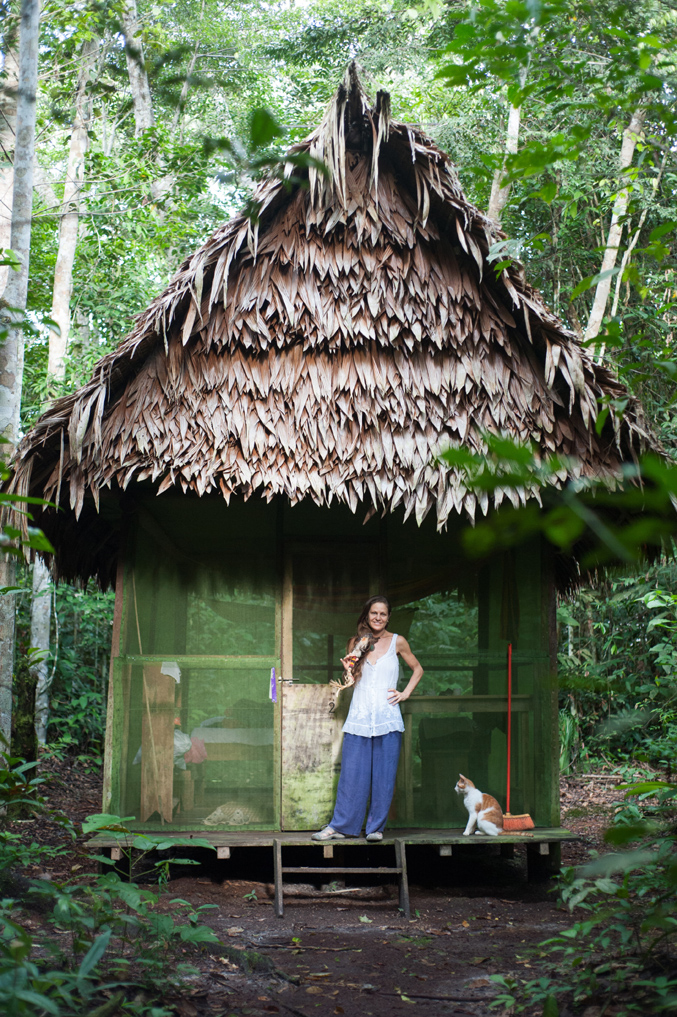 Plant Healer Sitaramaya at her tambo, an ayahuasca retreat solo jungle hut.
Plant Healer Sitaramaya at her tambo, an ayahuasca retreat solo jungle hut.
Reintegration
Ayahuasca goes right to the heart of any issue in an illustrative, multisensory way. It’s not like talk therapy, in which the analysand has to translate everything into a narrative line—even when it doesn’t happen in a line but is a complex everything-connecting-to-everything-else—and cram that representation into a billed hour. With ayahuasca, everything occurs as simultaneity. There’s no linear time. A realization that might take decades of talking to reach can be compressed into a few hours.
Robyn Lawrence had known for decades that her angst originated with her father’s fatal heart attack while her mother was still pregnant with her. But it was the insight of her ayahuasca journey that allowed her to change her interpretation of that event. “I’d had this weird story about it, that he didn’t want to meet me. It affected my ability to trust and my relationships with men. But in my vision, I saw him die, and he was thinking, ‘Oh sh*t, who is going to take care of this girl?’ My heart hurt the whole time.” She pauses, thoughtfully. “I would not have been able to heal that by talking.”
Amy Love’s final ceremony happened to be the one-year anniversary of her assault. “I went to the toilet and heard loud and clear, You must purge what stands in your way,” she relates. After vomiting, Love looked into the toilet and saw a bundle of skulls staring up at her. “I knew it was an entity from that man,” she continues. “I went from suffering and feeling awful to ‘everything’s fine’—it was very distinct.” Love happily flushed the commode of its contents and went back to the maloka, listening to the insects and plants singing in the night.
Love experienced the empowering, ennobling, mutually beneficial fusion of plant and human, of plant and woman, that carries forward, even after the retreat is over. On her third night of ceremony, Love had a sense of an “old grandmother” anaconda extending up through her spine, licking her third eye clean, stretching and shuddering, and then falling asleep inside her. “She’s still in there!” laughs Love. “I carried the medicine home with me.”
Rachael Carlevale had her own a vision of a mother anaconda coming in through her mouth, snaking down her body into her uterus and eating her tumor away. “She told me she was leaving a tiny piece as a reminder to keep on the path of this way of knowing. When I threw up, I knew I was purging up my tumor.” From that point on, Carlevale says, her healing “opened up.” She made progress in her remission. She was also finally able to change her diet. “I’d had a vision of myself as an infant suckling on my mother’s breast. I realized that this was when I had been most healthy and whole, this first drink of mother’s milk.”
“When I came back [from Perú] I had clarity,” Lawrence says. “I was more professional, more centered, stronger, better in myself.”
That is what the ayahuasca did for me, too—it made me more assuredly myself. It took the parts of me that had seemed disparate and accidental, and showed me how they were in fact an organic whole. I understood how my childhood, the books I’ve read, following my interests and passions, and the way the adults in my life had cared for me—all were preparation for the life I now lead. I understood that there are reasons we are drawn to certain things. Our souls love what they love, and they seed the timelines of our lives so that we will find what we need when we need it.
That cooperative healing is the gift that Zoe Helene wants women to be able to experience so that they might be a model for others beyond the grant’s circle. My own experience showed me what drives Helene to give these grants to women. “It’s science, magic, miracle,” explains Lawrence. “I think aya’ is spreading because the plants are saying, We need you, we need you to save us. And we’ll save you, too.”
All the women I interviewed want to return to Perú. I want to visit many other places, and it will be some time before I go back. So as I threw back that cup, I asked the ayahuasca to please, make it count. Make it count for a long time.
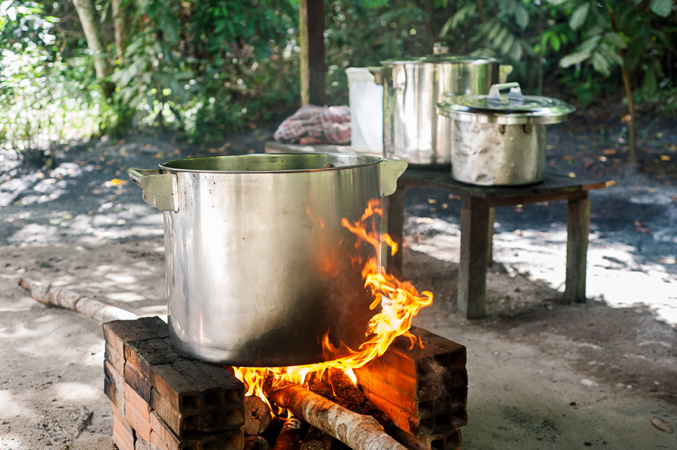
A First Timer’s Advice for Drinking Ayahuasca the First Time
- The real love affair here is between you and the vine, you and nature, you and your soul. Establish what that channel of communication feels like so you can really hear yourself and be alone with the soul you’ve been waiting for so long to meet.
- Read your primer, and put it away. Outfit yourself with the knowledge you need to be safe, get briefed by the shamans, then open up to the possibility that your experience might be very different from someone else’s (including mine). You might not throw up. You may not mind the ayahuasca’s challenging taste. You might have figurative visions, see energy patterns or experience internal knowings. Your experience is valid. Trust it.
- Be tender with yourself upon returning. “You might just want to be by yourself for a while,” says Rachael Carlevale. After Amy Love’s journey in November, she took the winter to truly rest for the first time in ages and had the sense of coming out of a chrysalis in spring.
- Beyond the personal healing, expect a sense of responsibility—a greater ecological consciousness in a mutually affective, mutually effective world—upon returning. “The ayahuasca is saying, ‘Now that we’ve healed his neurosis, now what?’” says Robyn Lawrence. “We have bigger stuff to do! You have better uses for your energy and time!”
- Expect your perspective—and maybe your life—to be shaken up. “My whole approach to landscape architecture changed,” says Susan Sheldon. “I had been trained in classical, built landscapes, moving earth, sculpting space. But this changed my focus. I realized that a healthy ecosystem is a messy ecosystem. It’s not on an axis. But then I had to change the aesthetics of my clients!” Rachael Carlevale felt that she was called to work for the plant—and all plants. “You can see the importance of saving the rainforest in this context,” she says. “The understanding of the plant world, of the living world, translates to everything—to the food you put in your body, to the intentionality of the farmer, how much of an impact we have, through the words we say, even how we look at people.”
See also: In My Element, documentary photography by Tracey Eller, Utne Reader
See also: Empowering Women’s Voices of the Psychedelic Renaissance, by Lynne Woodward, Utne Reader
--SUPPORT--
This story was made possible through the Cosmic Sister Women of the Psychedelic Renaissance and Cosmic Sisters of Cannabis educational advocacy project/s.
